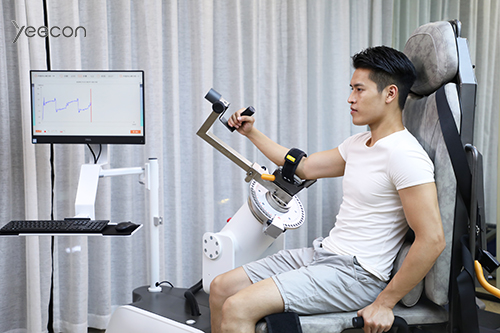Muscle strength is the body’s ability to complete movement by overcoming and fighting resistance through muscle contraction. It is the form in which muscles exert their physiological functions. Muscles perform work on the outside world mainly through muscle force. Decreased muscle strength is one of the most common clinical symptoms, and it often causes obstacles to various activities of daily living to the human body, such as sitting, standing, and walking obstacles. Muscle strength training is the main method to enhance muscle strength. People with decreased muscle strength often return to normal muscle strength through muscle strength training. People with normal muscle strength can achieve the goals of compensation and enhancing exercise capacity through muscle strength training. There are many specific techniques and methods of muscle strength training, such as nerve transmission impulse training, assisted training and resistance training. The maximum force that a muscle can produce during contraction is also called absolute muscle strength.
Basic Methods of Muscle Strength Training:
1) Nerve Transmission Impulse Training
Scope of application: patients with muscle strength grade 0-1. Commonly used for muscle paralysis caused by central and peripheral nerve injury.
Training method: guide the patient to make subjective efforts, and try their best to induce the active contraction of the paralyzed muscles by means of the willpower.
2) Assisted Training
Scope of application: Patients with muscle strength grade 1 to 3 should pay attention to changing the auxiliary method and amount with the recovery progress of muscle strength during training. It is often used for patients whose muscle strength has recovered to a certain extent after central and peripheral nerve injury and patients who need functional training in the early post-operative period after fracture operation.
3) Suspension training
Scope of application: patients with muscle strength grade 1-3. The training method uses simple devices such as ropes, hooks, pulleys, etc. to suspend the limbs to be trained to reduce the weight of the limbs, and then train on a horizontal plane. During training, different postures and pulleys and hooks in different positions can be used to design a variety of training methods. For example, when training the quadriceps muscle strength, the patient lies on the side with the affected limb on top. A hook is placed on the vertical direction of the knee joint, a sling is used to fix the ankle joint, and the calf is suspended with a rope, allowing the patient to complete the full range of flexion and extension exercise of the knee joint. The movement should be slow and sufficient, so as to avoid the lower limbs using inertia to do pendulum movements. During training, the therapist should pay attention to fixing the thigh to prevent swinging, which will undermine the training effect. Moreover, with the improvement of muscle strength, therapists should adjust the position of the hook, change the inclination of the movement surface, and use fingers to slightly increase resistance or use a heavy hammer as resistance to increase training difficulty.
4) Active Training
Scope of application: Patients with muscle strength above grade 3. Adjust the training speed, frequency and interval according to the specific situation of the patient.
5) Resistance Training
Suitable for patients whose muscle strength has reached grade 4/5
6) Isometric Training
Scope of application: According to the degree of recovery of muscle strength, patients with muscle strength of grade 2 to 5 can perform isometric exercise training. It is often used in the early stage after internal fixation of fractures, in the early stage of joint replacement, and after external fixation of fractures in plaster casts.
7) Isotonic Training
Scope of application: According to the degree of recovery of muscle strength, patients with muscle strength of grade 3 to 5 can perform isotonic exercise training.
8) Brief Maximum Load Training
The scope of application is the same as isotonic training. According to the degree of muscle strength recovery, patients with muscle strength of grade 3 to 5 can perform it.
9) Isokinetic Training
Different training modes can be selected according to the degree of muscle strength recovery. For muscle strength below level 3, you can first perform power-assisted exercise in continuous passive motion (CPM) mode for early muscle training. For muscle strength above level 3 concentric strength training and eccentric training can be applied.

Isokinetic Training with Yeecon A8
Principles of Muscle Strength Training:
①Overload principle: During overloaded exercise, the muscle resistance is greater than the load that has been adapted to at ordinary times, which becomes overload. Overload can greatly stimulate the muscles and produce certain physiological adaptations, which can increase muscle strength.
②The principle of increasing resistance: overload training increases muscle strength, so that the original overload becomes an adapted load, rather than an overload. Only by gradually increasing the load, so that the load becomes overload again, can the training effect continue to increase.
③From big to small: In the process of weight-bearing resistance training, the exercises involving the large muscle groups are carried out first, and then the exercises involving small muscle groups are carried out.
④The principle of specialization: the specialization of the body part for strength training and the specialization of the exercise motions.
Read more:
Muscle Strength Training After Stroke
Multi Joint Isokinetic Strength Testing & Training System A8-3
Application of Isokinetic Muscle Training in Stroke Rehabilitation
Post time: Jun-15-2022






